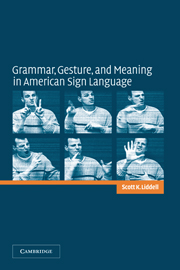Book contents
- Frontmatter
- Contents
- Preface
- Acknowledgments
- 1 American Sign Language as a language
- 2 A sketch of the grammar of ASL
- 3 Pronouns and real space
- 4 Indicating verbs and real space
- 5 Surrogates
- 6 Directing signs at locations and things
- 7 Tokens
- 8 Buoys
- 9 Depicting verbs
- 10 Five brothers
- 11 Grammar, gesture, and meaning
- Appendixes
- References
- General index
- Index of illustrated signs
6 - Directing signs at locations and things
Published online by Cambridge University Press: 05 June 2012
- Frontmatter
- Contents
- Preface
- Acknowledgments
- 1 American Sign Language as a language
- 2 A sketch of the grammar of ASL
- 3 Pronouns and real space
- 4 Indicating verbs and real space
- 5 Surrogates
- 6 Directing signs at locations and things
- 7 Tokens
- 8 Buoys
- 9 Depicting verbs
- 10 Five brothers
- 11 Grammar, gesture, and meaning
- Appendixes
- References
- General index
- Index of illustrated signs
Summary
This chapter examines two categories of signs. Signs in the first category are locative signs. These signs have a lexical requirement to be directed toward a location. Signs in the second category are typically produced in non-pointing citation forms. However, it is not difficult to find instances where the signs in this second category are spatially directed. In some cases such signs are directed toward locations and in others they are directed toward things.
The pronouns and verbs examined in previous chapters have the grammatical requirement to point toward entities corresponding to elements in their semantic poles. Given their grammatical requirement to point, the significance of the pointing is lexically fixed. That is, there is no need to wonder how to interpret PRO→a. The directionality of PRO→a identifies a as the pronoun's referent. Similarly, the directionality of TELL→a identifies a as the recipient of the information. For the nondirectional signs examined in this chapter, there does not appear to be any such grammatically fixed means of understanding the directionality. This suggests that neither the need to point nor the semantic function of the pointing are part of their grammatical description. To understand the significance of the ways these signs point, signers need to make use of context and the general cognitive ability to make associations.
Directing locative signs at locations
The sign THERE→L is a lexically locative sign used to talk about a location in the signer's environment. That environment could be real space or a blend with real space.
- Type
- Chapter
- Information
- Grammar, Gesture, and Meaning in American Sign Language , pp. 176 - 189Publisher: Cambridge University PressPrint publication year: 2003



